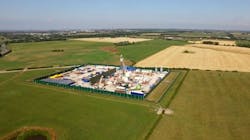Moratorium hits UK hydraulic fracturing
The UK government has imposed a moratorium on hydraulic fracturing out of concern for induced earthquakes, retreating from its support for development of natural gas resources in shale.
Its system of monitoring seismicity during hydraulic fracturing, which requires suspension of work when even minor tremors are detected, already had received criticism from operators as an effective ban on the completion method.
In April, the official UK advocate for shale-gas development resigned, citing “ridiculously low” seismicity thresholds (OGJ Online, Apr. 29, 2019).
The government announced the moratorium on Nov. 2 after the Oil & Gas Authority (OGA) published a report concluding that current technology cannot accurately predict the probability or strength of tremors associated with hydraulic fracturing.
“Ministers have always been clear that the exploration of England’s shale gas reserves could only proceed if the science shows that it is safe, sustainable, and of minimal disturbance to those living and working nearby,” a government press release said.
“On the basis of the disturbance caused to residents living near Cuadrilla’s Preston New Road site in Lancashire and this latest scientific analysis, the government has announced a moratorium on fracking until compelling new evidence is provided,” it said.
The statement added, “This position will be maintained unless compelling new evidence is provided.”
The OGA study focused on the Cuadrilla operation, where the operator has completed and flow-tested two horizontal wells in the Carboniferous Bowland shale.
Hydraulic fracturing has been suspended there since detection of a local magnitude 2.9 tremor on Aug. 26 in the second Preston New Roads well, PNR2, where testing continues.
On Oct. 29, Cuadrilla said, “Early flow test data was very encouraging” and called gas from the Upper Bowland shale in the PNR2 well “the highest quality yet encountered by Cuadrilla in its UK shale exploration activities.”
The high-calorific gas, it said, contains about 89% methane, 6% ethane, and 2% propane.
After publication of the OGA reports leading to the frac moratorium, Cuadrilla said it will “review these interim reports in detail and continue to work constructively with the OGA to provide further detailed data (including data from the PNR2 well) to address concerns so that the moratorium can be lifted and the highly prospective Bowland gas resource further appraised and developed.”
Like Cuadrilla, IGas Energy PLC, which has established shale gas potential in Nottinghamshire with the vertical Springs Road-1 well, promised cooperation.
“We will continue to work closely with the relevant regulators to demonstrate that we can operate safely and environmentally responsibly,” it said in a statement responding to the moratorium.
Ken Cronin, chief executive of UK Onshore Oil and Gas, also promised to work with OGA and other authorities and emphasized “the size of prize at stake.”
He said, “Flow-testing and core sampling across Lancashire and North Nottinghamshire show that our high-quality indigenous gas can reach the surface, leaving the UK with no excuse to continue importing overseas gas that generates double the emissions and provides British workers, businesses, and communities with no economic benefit.”
